I’ve long admired and drawn inspiration from Chris Liberti’s paintings and his remarkable devotion to advancing his artmaking. His desire to continually expand the fields of view with his compositions as well as exploring new possibilities for color has been exciting to watch unfold as he posts his new images to social media. I was very pleased when Chris agreed to do an interview with me and we recorded a long phone conversation from his Charlotte, NC studio that we later edited to better explain his approach to painting. Since there is already an interview on Savvy Painter where Antrese Wood goes into detail about his background and inspirations, we decided instead to focus more on his current work and life. I would like to thank Chris for his generous contribution of time and energy, not to mention patience, with the making of this interview.
Chris Liberti was born in Buffalo, NY, and began his involvement with artmaking at an early age. He studied at Buffalo State College with the realist painter Jim Phalen. He is represented by the galleries: Blue Spiral 1 Gallery, Asheville, NC; Meibohm Fine Arts, East Aurora, NY; John Natsoulas Gallery, Davis, CA; Thomas Deans Fine Art Gallery, Atlanta, GA; Shain Gallery, Charlotte, NC; and Anderson Fine Art Gallery, St. Simon’s Island, GA.
In a quote from an essay written by John Seed:
…Gesture, color, and surface enliven the new harmonies and patterns Liberti creates as he works, generating a distinct back-and-forth between representation and abstraction. Although there are certainly similarities that connect his works, each completed painting stands on its own: a distinct vision that Liberti has shepherded towards a necessary and unique conclusion. Some paintings come to the edge of realism, while others feature willfully invented patterns, intersections, and overlaps.
“I often find myself in a struggle between abstraction and representation, “ Liberti comments. “I don’t want to lock myself into being one or the other. Working abstractly is freeing since there is more looking involved: more than simply looking at what was being painted.”
Liberti is a very direct, visually oriented artist who is relatively unconcerned with theories or conceptual underpinnings. He is also a painter without pretensions who speaks of his artistic process in very straight-forward terms: “I simply enjoy the process of painting, working with my hands, looking, mixing, adding a spot of color, standing back, looking and going in again.” He is a formalist who values perceptual experiences more than symbolism or context.
In an era when too many artists work harder at promoting themselves than at making art, Liberti is something of a rarity. He has a work ethic like Wayne Thiebaud’s: going to the studio means going to work. When he is standing at the easel Liberti keeps a few simple goals in mind: “I try to remain sincere and rely on instincts while reminding myself of things I’ve learned and where I want to go at this moment.”
Larry Groff: I understand that you have a few new shows coming up soon, when and where are these going to be?
Chris Liberti : I have an exhibition currently running through December 6th here in North Carolina at Wingate University’s Hinson Art Museum which will include work from the past 5 years. I’m in a group show this December at Booth Gallery in NYC, and a solo show in March 2020 in Asheville, NC at Blue Spiral.
LG: When you plan for a solo show what do you mainly think about? Is it important for you that your work hangs together thematically in some way, like the subject matter or formal concerns?
CL: It hasn’t mattered to me so much in the past, but I am recognizing the necessity to explore a theme, be patient and stick with it. I often get distracted by what catches my attention on my daily encounters and feel the need to paint them, the eye is always on the pursuit. It takes a lot of time to develop a cohesive body of work, there are ideas that can take you on paths that lead nowhere while others open up to unexpected territory. It’s important for me to entertain these various ideas, then I can assess and gauge their value as I work towards something cohesive.
LG: Do you ever feel the need to scale down the sizes of the paintings to meet any upcoming deadlines?
CL: I often spend just as much time on a small painting as I do on a large one. You’re still working out the same problems. It’s a smaller size but the time isn’t just about how much coverage you need to paint but more about the problems that need to be resolved.
I want to spend more time to focus on the quality over the quantity of work. Unfortunately, I had to turn down a couple of opportunities because of this. I’d like to have more time to explore, dive deeper, and let the paintings slowly take shape before putting them out there.
LG: You seem to be successful with showing in several galleries and of course your work is terrific so it is understandable that you would do well. However, I’m curious to know about how you got into your galleries? What things have you done to promote your career as a professional painter?
CL: This is an interesting subject with many contradictions. I initially did not want to or thought it was even possible to become a professional painter. This is and should always be a deeply personal experience in the making of the work but once the making of it is done, it ultimately needs to be shared.
I’d have to say that social media has been the biggest boost for me as a promotional tool. I have submitted my work to galleries in the past and I’ve had some opportunities come by way of that. I think I felt at the time that I needed some sort of validation through representation. I’m realizing now that I’d rather spend more time with the work than trying to get it out there. There is still much development needed.
Social media can be extremely helpful towards building an audience but at the same time, it can cloud one’s perspective and create falsehoods that surround my own perceptions of what is acceptable as strong work. It’s a bit like groundhog day and politically toxic. There needs to be more time spent on the craft and less on the promotion. It’s too easy to post a mediocre painting on social media and get loads of likes, shares, comments. It’s ultimately up to us to decide and I want to get back to that, allowing the work to marinate longer, searching for what the work is really calling for without the distractions.
LG: That’s an important point. Sometimes it’s easy to confuse the number of likes with a painting’s success (or lack of). Obviously “likes” are pretty meaningless because you don’t know anything about why they clicked or didn’t click on it.
CL: That’s right, and this can be extremely dangerous to how you perceive your own work. On the other hand, social media creates an amazing opportunity to access brilliant work from all over. It’s a good community, sometimes almost too positive. It’s good in many aspects but at this juncture, I’m going to limit my usage for a while in hopes of returning to the challenges that originally excited me about painting.
LG: You have a recent posting to Instagram, a painting called Backyard Meditations in Green. Getting an all green painting to work this well isn’t an easy thing to pull off. A marvelous painting but seems different from other works you are currently posting. It struck me that you must like to frequently experiment with different ideas for a painting and I’m curious, do you work more than one painting at a time? Or do you just work one thing at a time and only then move on to the next.
CL: That magnolia tree is in my backyard and we’ve been staring at each other for the last 4-5 years, knowing that I will attempt to paint it at some point. It was a welcomed challenge and I was keen on playing with the warm and cool greens and subtle value shifts, practice more than anything.
What painting means to me seems to change over time, the formalities and how it’s emotionally perceived. I have to go through all the possibilities, and I embrace the unexpected. I want the work to remain pure without any external pressure or motives. Some days I want to work slow, some days fast, some days messy while others clean, depends on my mood really, I don’t want to hinder that. The mood has to be incorporated, it’s not simply picture-making, it’s an experience. The possibilities are quite maddening and extremely fulfilling at the same time.
LG: I read that you prefer to work from observation on some level. Is that still the case? How central is observation to the creation of your work?
CL: Lately I’ve lifted those restrictions and I find that I’m using everything and anything at my disposal. I used to think that somehow it mattered how I arrived at a finished painting, judging myself. I’m thinking more about paintings as stage sets where anything is possible, while everything and anything is usable. My brain feels like Francis Bacon’s studio, it’s a good place to be. There is an endless cornucopia of material floating around, and trying to reinvent the wheel with each new start can be daunting. It’s a huge shift in my thinking to know that I can use this photo, a story or a piece of fabric or whatever as a starting point, and from there I’m allowed to go anywhere. Having a phone to snap pictures at any moment is a remarkable tool to have at our disposal as well. I don’t want to limit myself anymore. However, all the work I’ve done over the years from observation has helped tremendously – the experience of painting from life will find its way into the work.
LG: That’s great, it must feel liberating! I’m curious, when you’re inventing the color and not finding and mixing colors you’re seeing in life, do you ever find a tendency for your color palette to gravitate towards using particular colors or mannerisms with how you use color?
CL: It’s all color invention really, then relating those inventions to the other inventions throughout the entire surface. To break out of mannerisms or cliché I’ll often look at other artwork and copy the color. I’ll pay attention to value and temperature and figure out how I can relate that into my painting. I recently found a couple of colors that I thoroughly enjoy using after researching Rembrandt’s palette. (Red ochre and brown ochre). I’m currently looking at Roman frescoes and alter paintings from Sienese painters like Lorenzetti brothers and Giotto to explore composition and color possibilities.
LG: You have lived in a number of places including California and you lived NYC for some time. How is living in Charlotte for a painter?
CL: My family and I have been in Charlotte for five years. Ejona, my wife and we have 2 girls, Lucia and Maya and 1 baby boy, Leo. It has taken about four and a half years for Ejona and I to adjust. We met in New York City where we lived for 9 years and then in Buffalo, NY and on to Long Beach California before moving to Charlotte. It was just a completely different speed for us here. Visually and culturally, for me, it doesn’t have as much to offer as some of the past places we’ve lived. This has been beneficial in a way that I don’t have to rely as much on outside stimuli; which forces me to look internally. I have to say though that it is a fantastic place to raise a family and the weather is pretty good. The city is rapidly growing and there is a decent art community as well.
LG: Do you just teach and paint or do you have some other work you do as well?
CL: I teach a few workshops a year and I also work part-time as a telecommunications design engineer. I work remotely and have been doing this for about 10 years. It’s pretty low pressure and is helpful to have that extra income. Most of all it allows me time to paint – #blessed. I also dabble in music production/engineering and own/manage some rental properties, my retirement fund – #retirement.
LG: What is your typical painting schedule like in your studio?
CL: I paint as much as I can. And that’s usually five to six days a week, Monday – Saturday. about 5 to 7 hours a day with the option of a couple of hours on Saturday. I become more confident, clear, and the ideas flow much better when I’m consistently working. I’m also a better person when I’ve been painting more as well. If I have a few days or a week away from the studio, there’s a bit of a hill to climb before the gears move freely.
LG: Do you sort of zone out while painting and totally focus on the painting, pushing the outside world out of your mind?
CL: It’s like meditation, a re-set. I like paintings where I don’t know how they’re made, where I don’t see the person’s process. Where the artist takes themselves out of the equation and surprises you. You are thinking of many different things while you’re painting, concentrating on mixing colors, adjusting tones or remembering what a friend or one of my professors had said to me back in 1993. I also find sometimes listening to music while painting can be a nice distraction. Silence is also wonderful, especially when you have 3 kids.
LG: What kinds of music do you listen to when you’re painting.
CL: I lean towards mellow music, on the darker side. Film scores from contemporary composers like Jonny Greenwood of Radiohead (Phantom Thread) and Geoff Barrow of Portishead (Ex machina). Currently, I’m also listening to a lot of Wilco, War on Drugs, Beach House and Phoebe Bridgers, bands like that. I used to work as a sound engineer, writer/producer when I lived in NYC so music has always been a huge influence on my craft. As a kid, I would spend my days listening to music and drawing the album covers. I guess I’m essentially doing the same thing all these years later, ha. I still dabble in writing and music production at my home studio.
LG: Sounds like some great choices. When I paint I like music that doesn’t intrude on my concentration and doesn’t contradict the mood of the painting I’m working on. So music with great background ambient qualities–like Philip Glass, Steve Reich, Terry Riley, and Brian Eno they tend to stay in the background for me and don’t interfere emotionally.
CL: Yes, that’s important that it doesn’t interfere. Much respect for Brian Eno, love his work with Talking Heads.
LG: I in some of your work from a few years ago, you made a few works, Amsterdam cityscape I recall, seemed strongly influenced by Paul Klee. I was impressed that you stuck that out that there was such a serious body of work devoted to studying that must have helped your color. I’m curious about what you have to say about that.
CL: Yes, Klee is definitely an influence. I’ll simply have a Paul Klee book open and again, I’ll try to copy/emulate the color and use it in my work. What I admire most about him aside from his mastery of color is his inventiveness, how freeing that must be.
I’ve had a lot of focus on the formalities of painting, the technicalities, and getting comfortable with them. The craft and the skills required to paint are essential but more importantly, there has to be a feeling. How is that learned?. I’ve currently hit this plateau and I’m trying to implement all these past experiments. I feel things are opening up a little more and I can start putting the pieces together. It feels as though it had all been just practice up until now. It’s a long road ahead, but I need to push myself further. Painting is so elusive but I’m beginning to trust myself that in some moments it can be found.
LG: Can you say something more about how you use color in your work? I’m particularly interested in thoughts about simplifying things down to large areas of color working together.
CL: Usually the painting starts out with more but invariably becomes less. I’m always looking to express myself in the fewest of words or details. As they are worked and re-worked I tend to find that most of it becomes unnecessary. I’ll stumble upon larger areas where you can have these visual breaks that allow room to breathe. Take a look at Diebenkorn’s Ocean Park series. There’s this buzz going on in one corner while the majority consists of vast open spaces, but you still see some of the thought process there. It’s really a nice place to settle in to.
LG: I love your paintings that have large areas of flatter, simple color with very close values. The color feeling you get out of these close valued paintings, the sense of light, form and air are quite exquisite.
CL: Thank you. I’ve been very much interested in working with warm and cool relationships that have subtle value transitions. Being aware of value and temperature is more important than the exactness of nature. More can be said with less in the world of paint. I often remind myself when working to ask myself these 4 simple questions: is it too warm or too cool, is it too light or too dark? I try not to be too analytical or theoretical about it.
LG: That was also important with Leonard Anderson’s teaching. Hearing him talk about comparison. How painting is about comparing qualities where you are constantly looking at your canvas and comparing it to what you see in the motif. And ask yourself, Is the thing you’re painting lighter or darker, warmer or cooler than what you see, bigger or smaller? But when you’re working out in your head you don’t have anything to compare–you just have the painting and your mind. And so you create this kind of world you know with its own internal logic its own color space and the rules of what is going to work and what’s not. So is it too light or too dark for this situation in the painting?
CL: Yes, and to remind yourself to take some liberties with that as well.
LG: I read where you talked about how daily life finds its way into your work. And I found that a really curious thing to say and I’m sort of wondering if you might have anything more to say about that?
CL: Not only how do I respond to my environment but how do I translate that idea through the medium? It’s really the simple things for me to use as vehicles. Merely living and looking, you get a sense of how something may become subject matter. The juxtaposition between the interior and exterior, light and shadow, space being created through shapes of color and value. And then it’s things like my kids will accidentally leave the perfect still life set up on their nightstand. I could never set something up like that. I could also be influenced by a book I’m reading or what I’ve seen/read on the news, a pattern on a dress or a tree on my morning walk. It’s endless really. The subjects themselves are merely pathways to somewhere entirely different.


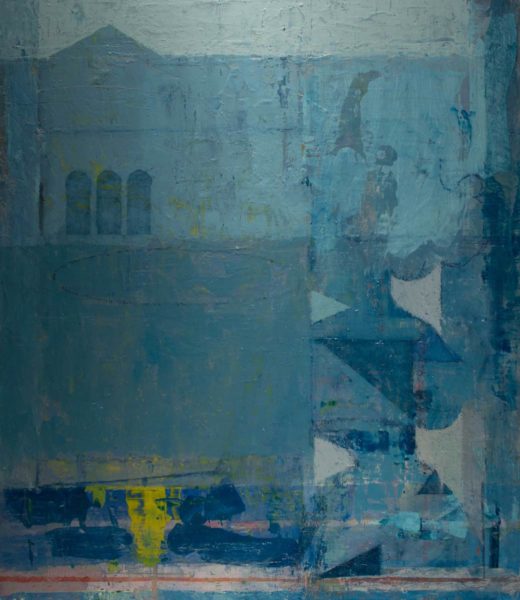
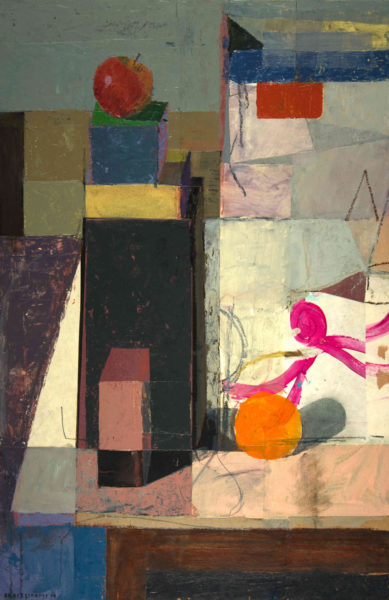
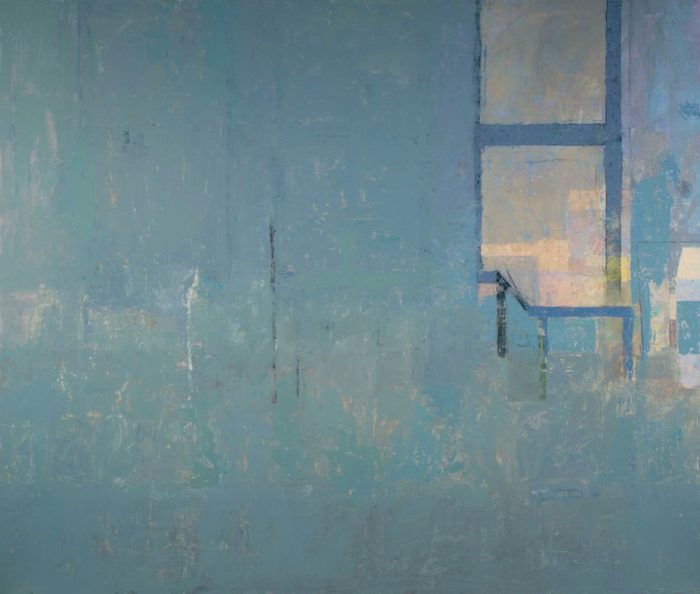
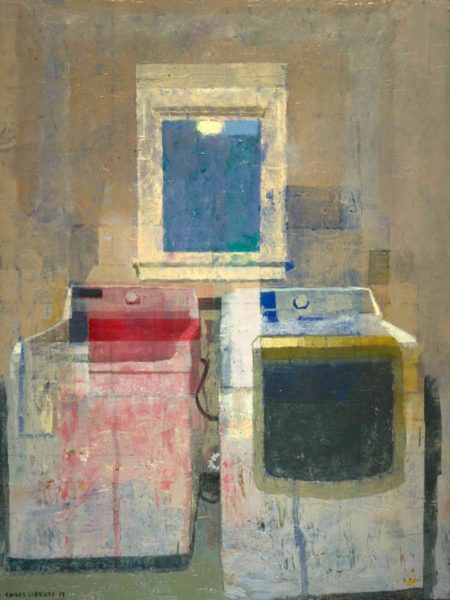
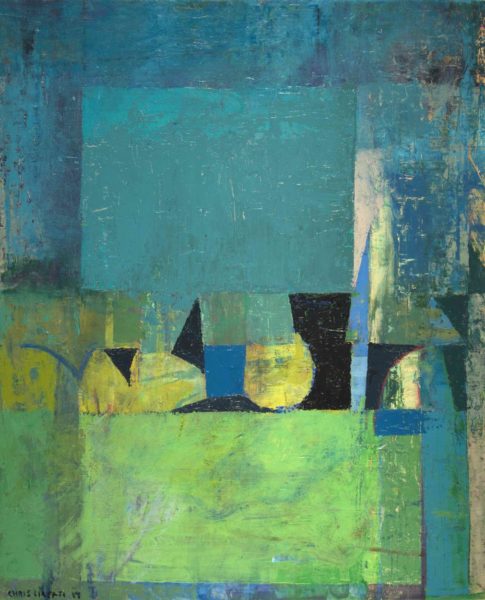

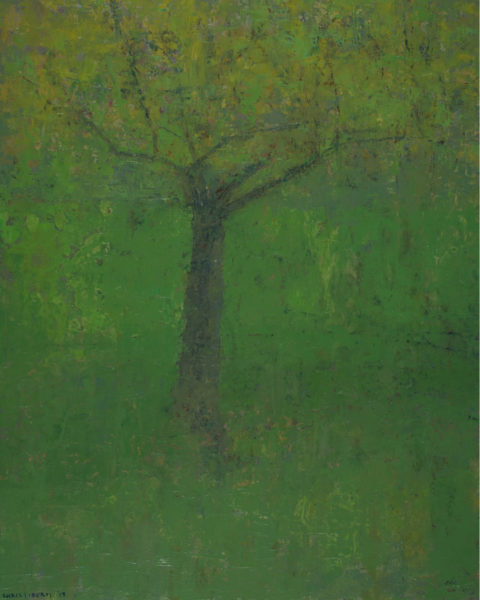
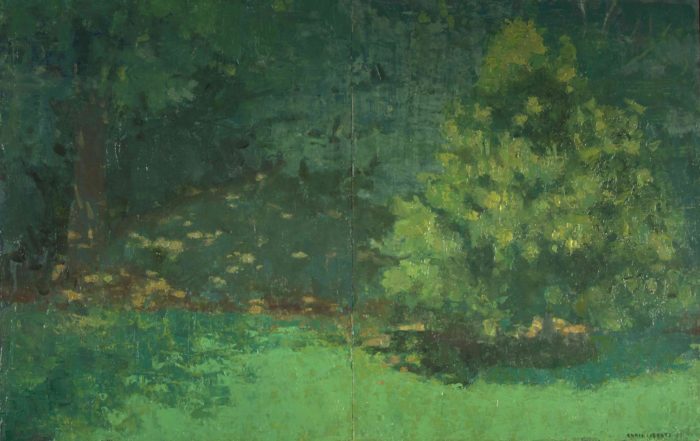
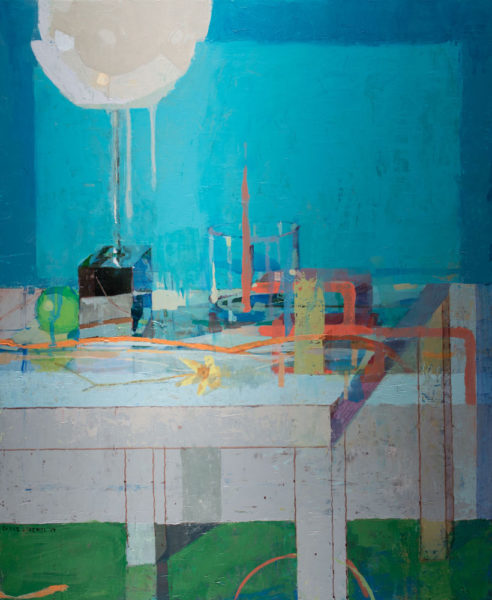
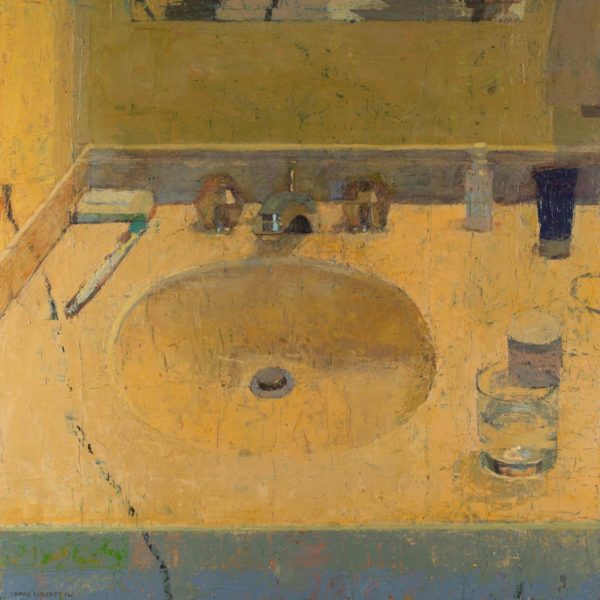
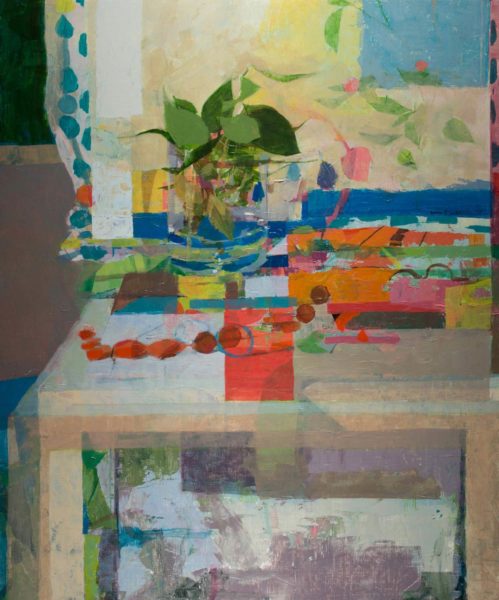

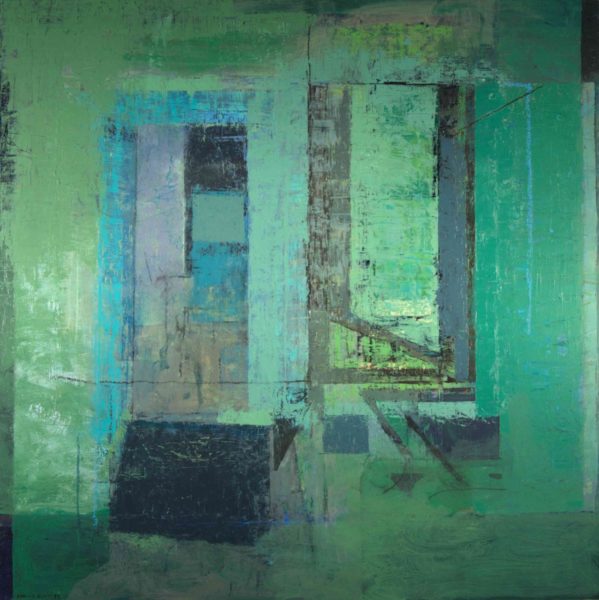
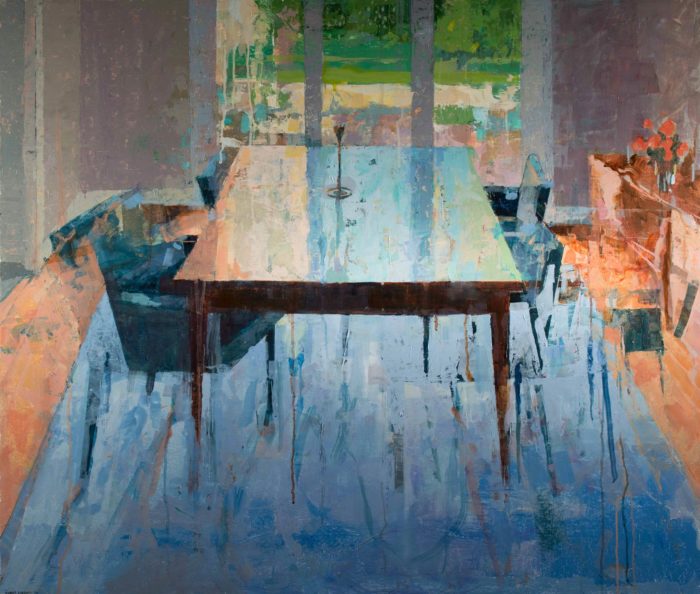
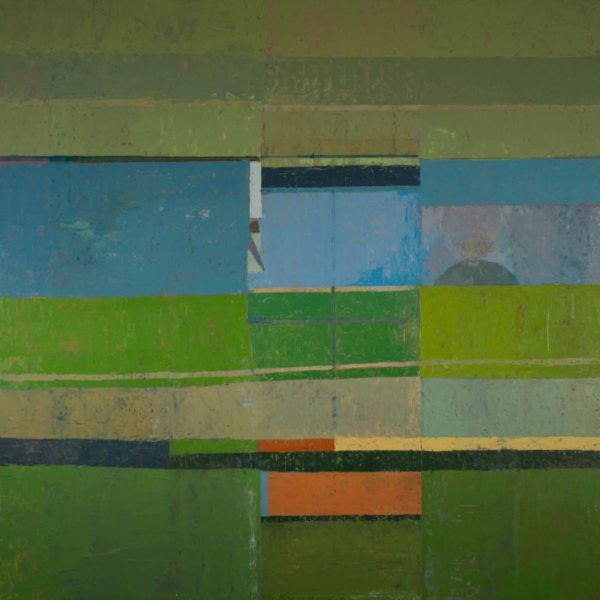
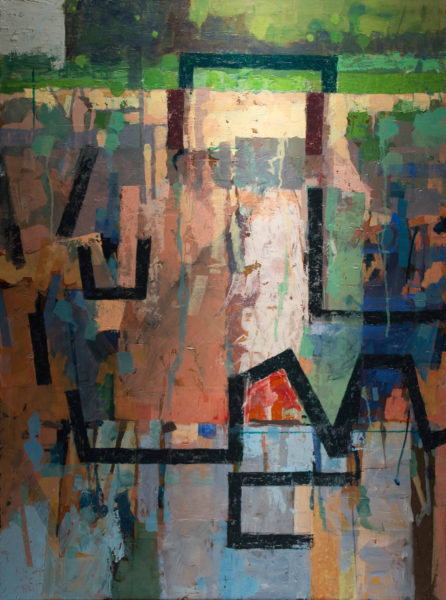

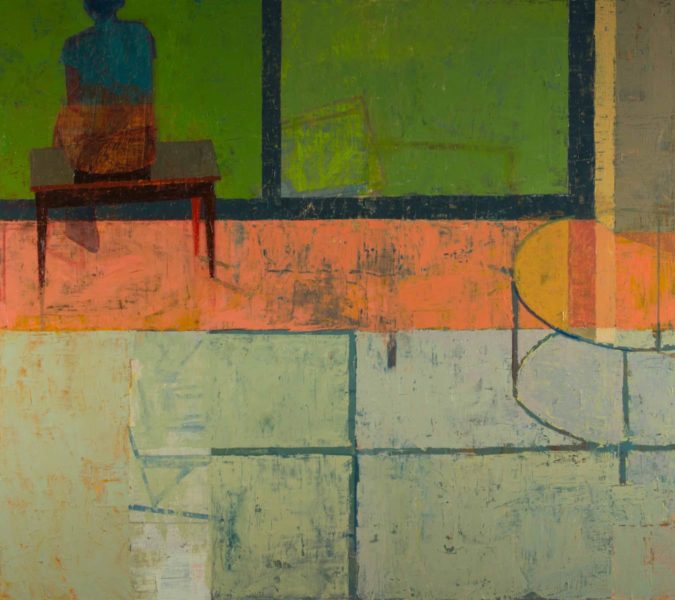
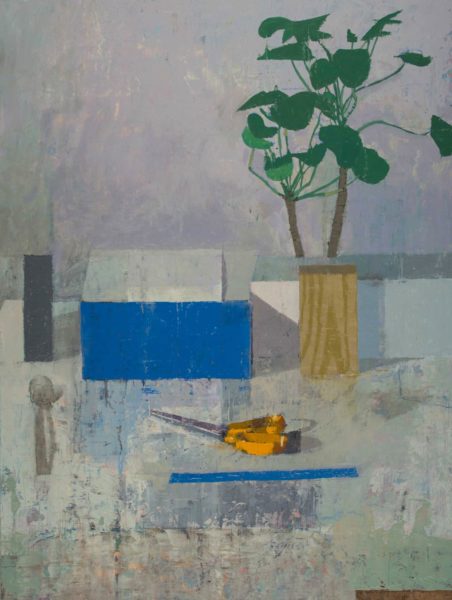
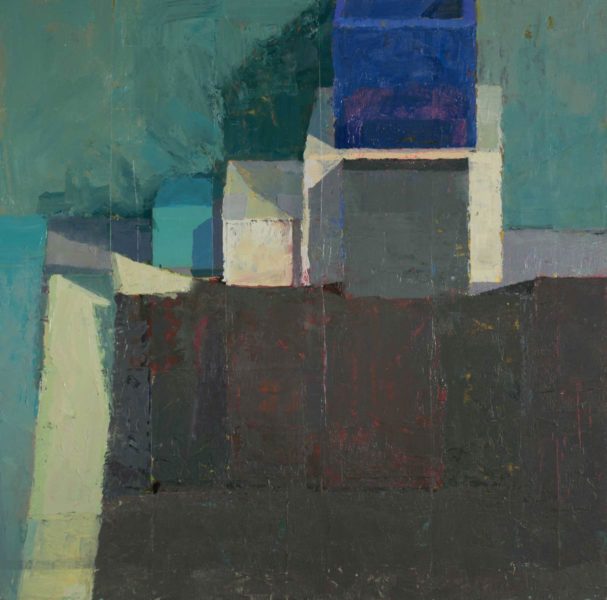
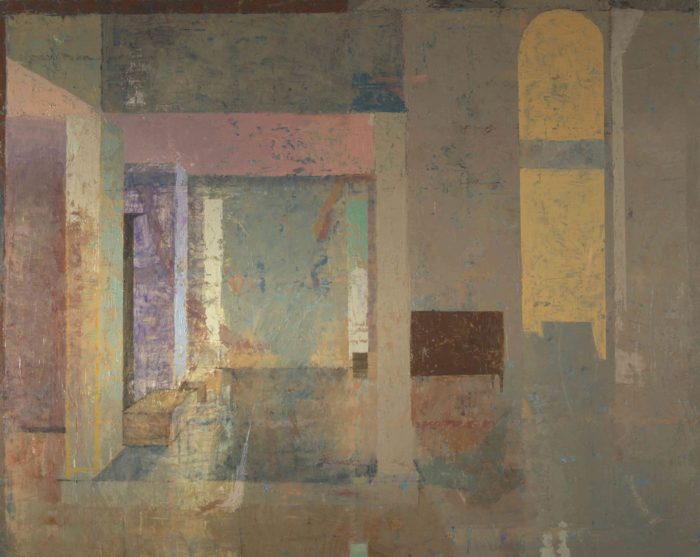
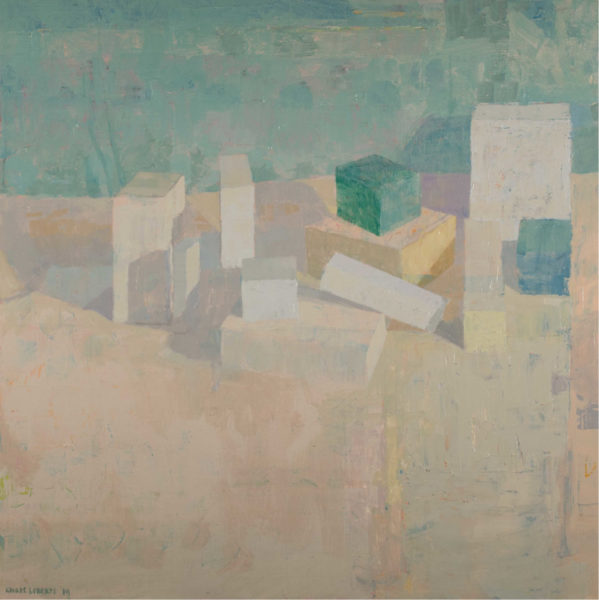
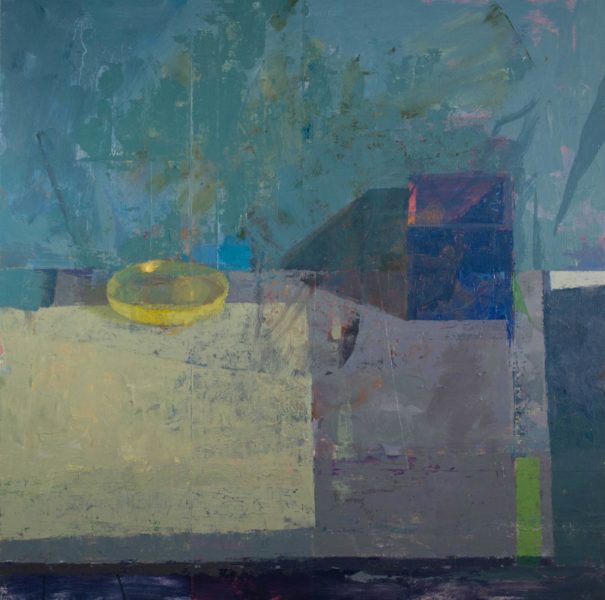
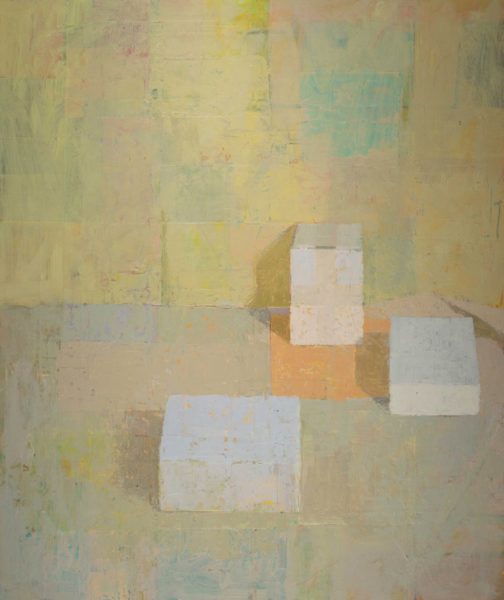
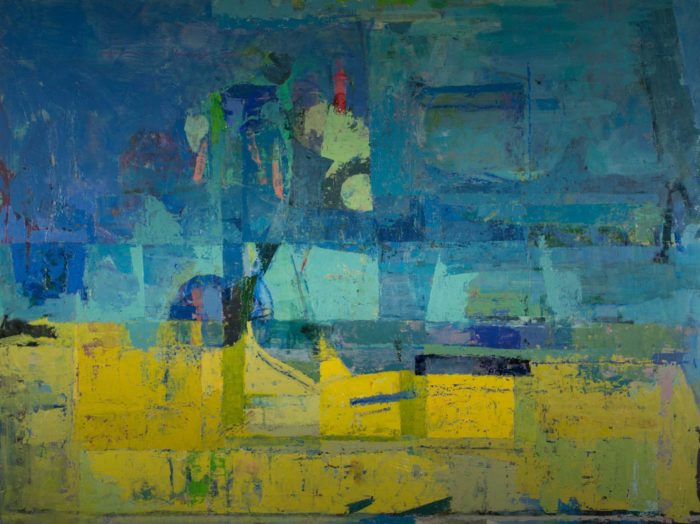

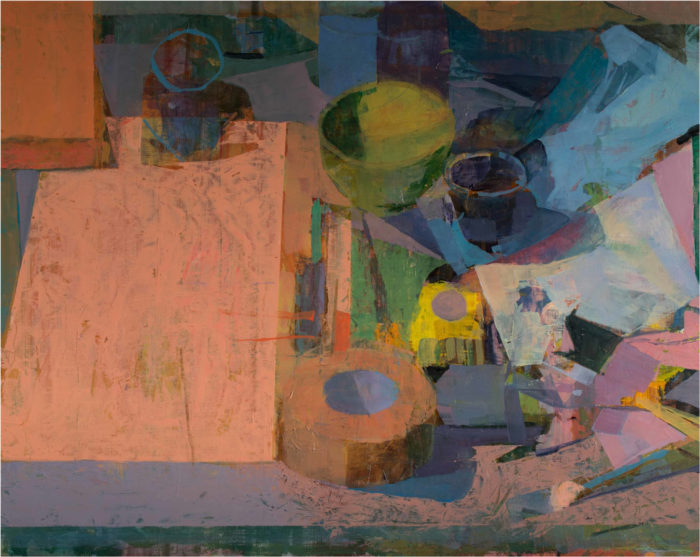
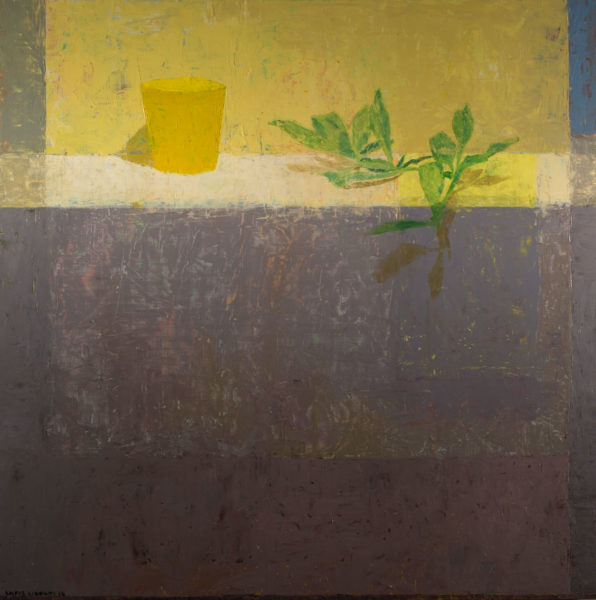




Reflective and interesting.
Excellent interview – thanks to you both for making it happen
Knock out paintings and an excellent te
Thank you Mary Jo for your feedback, much appreciated
This is an excellent interview.
As always intelligent questions from Larry and very insightful answers from Chris. The paintings are really beautiful and so interesting in many ways.
I absolutely love how the paintings dip in and out of naturalism from their very formal abstract constructions. ..Bravo Chris!
Thank you both for putting this together.
Love the subtle and lyrical mixture of abstraction and representation. Some of the work exhibiting overlapping planes and geometricism call to mind Euan Uglow.
Thank you so much for the interview. It’s helped order some thoughts I have about my own practice. Beautiful paintings.